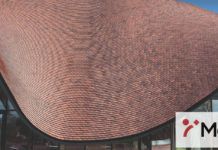
The damage caused by storm Doris back in February is an important reminder of why a revised BS 5534 came into force in 2015. 95mph winds battered the country, causing damage to homes and buildings, with some reports of roofs collapsing or being blown off. Extreme weather like this is becoming increasingly common and the destruction caused by strong winds and torrential rain demonstrates the importance of making sure roof coverings and accessories are mechanically fixed in line with the British Standard.
BS 5534:2014+A1:2015 was introduced specifically to make pitched roofing more secure in the face of increasing volatile weather and to bring us in line with the Eurocodes. Yet, despite its contribution to roof security, BS 5534 is not yet included in the Approved Documents to the Building Regulations and in fact, the only reference to roofing is more than two and a half decades out of date! It is incredulous that, as it stands, a roof could meet Building Regulations but be significantly under specified by modern standards, including the possibility of having incorrectly specified materials, with the added risk of outdated construction methods and more worryingly, insufficiently fixed roof coverings and accessories.
In fact, it is such a critical issue that the National Federation of Roofing Contractors (NFRC) is leading a cross industry group of stakeholders to lobby Government to get BS 5534 included into the Approved Documents to the Building Regulations. This is something which Marley Eternit is supporting fully, alongside the other members of the British Standards committee responsible for BS 5534 and BS 8000-6, including the Roof Tile Association (RTA) and other influential industry representatives.
Kevin Taylor, head of technical services, from the NFRC is leading the campaign and told us: “Because BS 5534 is not specifically referenced in the Approved Documents to the Building Regulations, this can cause challenges when it comes to both quality control and enforcement.
Currently only BS 8000-6: 1990 is referenced in Regulation 7 and Approved Document Part C. This means the only reference to roofing within the Approved Documents is effectively 27 years out of date and naturally much has changed in relation to workmanship since then, so it is vital this is updated.
“In addition, BS 5534:2014+A1:2015 sets out some important changes to the safe and secure fixing of roofs and we are working alongside our partners to strongly recommend it is included in Approved Document A. Until that time, we will be continuing to raise awareness of the importance of installing and fixing roof coverings to BS 5534. Both the NFRC and Competent Roofer believe that unless roofs are fixed properly, then this constitutes a real risk of roof failure or possibly even injury to people and damage to property, especially in high winds.”
Re-roofing issues
While members of the NFRC and of the Competent Roofer Scheme are required to fix to BS 5534 recommendations, sadly this isn’t the case for all roofers and general builders. In fact, Kevin Taylor, of the NFRC, estimates that as much as 80% of re-roofing work in the UK is not being done to the British Standard, putting roofers and property at risk. It also creates pricing challenges for those contractors who are competing against roofers not installing to the standard.
So, while there is work underway to try and give more power to enforce the use of BS 5534, in the meantime, manufacturers and bodies like the NFRC, RTA, Local Authority Building Control (LABC) and the Building Control Alliance are working to encourage all roofers to follow the British Standard.
We spoke to Phil Hammond, managing director of LABC, who explained: “We fully support the NFRC and its partners in the bid to improve the quality of roofing and workmanship in the UK. We are working with the Building Control Alliance and encouraging all building control surveyors to follow the best practice guidelines of BS 5534:2014+A1:2015 and we have technical guidance and brochures available to support them in doing this. Unfortunately, at the moment, BS 5534 is not referenced in the Approved Documents, so we have to devote extra time and resources to build awareness and explain the improvements. We support industry and the NFRC in its campaign for this to be clarified in the Approved Documents.”
BS 5534 is the British Standard Code of practice for roof slating and tiling and it simply isn’t worth the risk not to follow it. Even though it isn’t mandatory yet, if roofing is not carried out to BS 5534 and the work is challenged, it will invariably need to be put right (unless there are exceptional circumstances such as heritage work). In fact, the NFRC has seen situations where non-compliant roofs have had to be stripped and re-done when the homeowners have complained.
Making BS 5534 a legal requirement would ensure all roofing is done to the right standard, making it much easier to enforce and creating a level playing field for contractors to price.
As well as the campaign to include BS 5534 in the Approved Documents to the Building Regulations, the forthcoming British Standard for Dry Fix Roofing Systems is another significant factor which will undoubtedly help to improve the security of pitched roofing against extreme weather. For too long there have been inconsistencies in the quality of components between different systems and the new British Standard will hopefully be a wake-up call to the whole industry. Ultimately, just because something is ‘dry fix’ doesn’t mean that it’s inherently durable; it depends on the overall quality of the components used in the system and their correct installation.
Undoubtedly BS 5534:2014+A1:2015 is already helping to improve the security of pitched roofing but, if it is really only being followed on 20% of roofing projects at the moment, then there is clearly a lot of work to be done. The campaign to add BS 5534 within the referenced standards in the Approved Documents to the Building Regulations, coupled with the introduction of a new British Standard for Dry Fix Roof Systems, will be invaluable steps in ensuring we can continue to raise the standards of roofing in the UK and protect both property and homeowners alike.
How would including BS 5534 in the Approved Documents to the Building Regulations benefit contractors?
- Reducing re-work costs – following BS 5534 means there is less risk of having to go back to do any re-work as a result of storm damage. It also helps to reduce claims against any warranties you may offer.
- Protecting reputation and reducing liability – fixing to BS 5534 protects your reputation for quality workmanship and reduces risk.
- Improving safety on site – reducing the risk of accidents arising from non-compliant materials being used e.g. using incorrect roofing battens as a foothold.
- Protecting homeowners and occupants by ensuring the roof is safe and fixed to modern high standards.
- Creating a level playing field – if BS 5534 becomes a referenced means of compliance within the Approved Documents to the Building Regulations, it will mean everyone will be pricing against the same levels of fixing, making it much fairer for both contractor and consumer.



